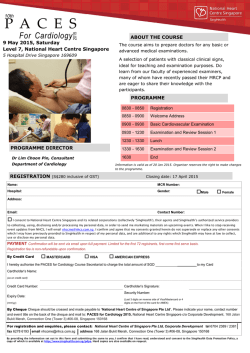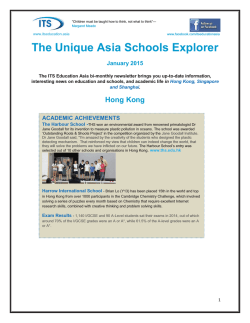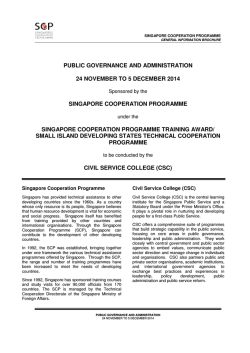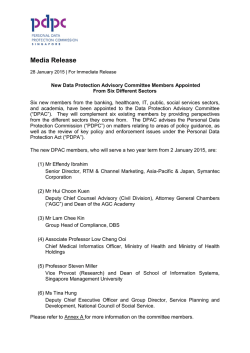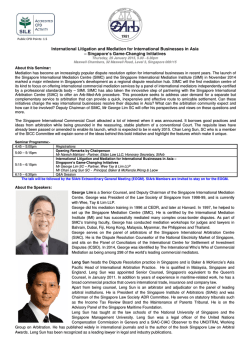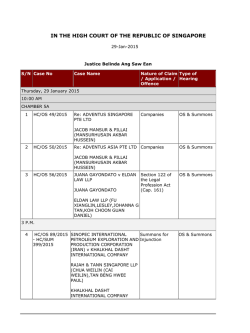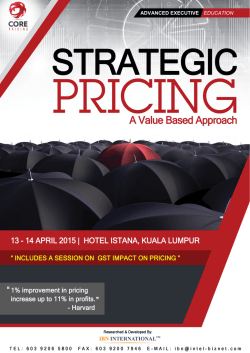
Seminar Slides on Transfer Pricing Documentation
Guidance on Transfer Pricing Documentation Ms Chan May Ling M Ch M Li Tax Specialist Corporate Tax Division Corporate Tax Division Mr Ng Songhua p ( ) Tax Specialist (International Tax) Tax Policy & International Tax Division 09 February 2015 (Monday) www.iras.gov.sg Twitter.com/IRAS_SG Facebook.com/irassg 1 © 2015 Inland Revenue Authority of Singapore. All Rights Reserved. Agenda Singapore Transfer Pricing Regime Transfer Pricing (TP) Documentation What is TP documentation Why prepare TP documentation When to prepare TP documentation How to prepare TP documentation Compliance matters relating to TP documentation What you need to know about transfer pricing audit and adjustments 2 © 2015 Inland Revenue Authority of Singapore. All Rights Reserved. Si Singapore Transfer Pricing Regime T f Pi i R i 3 © 2015 Inland Revenue Authority of Singapore. All Rights Reserved. Singapore TP Regime Singapore TP Regime Conducts MAP & APA under DTAs MAP & APA Legislation Legislation in Income Tax Act ( (2009) ) Enacted S34D on S34D on “Transactions not at arm’s length” Provides guidance P id id via e‐Tax guides, information at information at TP guidance IRAS website (2006) TP consultation (2008) Conducts TP consultation (e‐Tax guide) 4 © 2015 Inland Revenue Authority of Singapore. All Rights Reserved. Singapore TP Regime Singapore TP Regime IRAS published an updated e‐Tax guide on Transfer Pricing Guidelines (second edition) on 6 Jan 2015 Pricing Guidelines (second edition) on 6 Jan 2015 It consolidated four previous e‐Tax guides to provide p g p more comprehensive guidance: Previous e Previous e‐Tax Tax guides guides Transfer pricing guidelines Transfer pricing consultation Transfer pricing consultation Supplementary administrative guidance on advance pricing arrangements advance pricing arrangements Transfer pricing guidelines for related party loans and related party services loans and related party services Date 23 Feb 2006 30 Jul 2008 30 Jul 2008 20 Oct 2008 23 Feb 2009 5 © 2015 Inland Revenue Authority of Singapore. All Rights Reserved. What is Transfer Pricing What is Transfer Pricing It concerns prices charged in transactions between p g related parties Transaction between unrelated parties Transaction between unrelated parties Conducted at a price approximating to the market price T Transaction between related parties ti b t l t d ti May not be reflective of market prices h f d Tax authorities may impose transfer pricing adjustments when pricing is not reflective of market prices Taxpayers should apply the arm Taxpayers should apply the arm’ss length principle to length principle to manage transfer pricing risks 6 © 2015 Inland Revenue Authority of Singapore. All Rights Reserved. Arm’ss Length Principle Arm Length Principle IRAS endorses the arm IRAS endorses the arm’ss length principle as the length principle as the standard to guide transfer pricing Market forces of supply & demand are the best way to Market forces of supply & demand are the best way to allocate resources & reward effort TTaxpayers & tax authorities will have a common basis to &t th iti ill h b i t deal with related party transactions & the incidence of transfer pricing adjustments will be reduced transfer pricing adjustments will be reduced 7 © 2015 Inland Revenue Authority of Singapore. All Rights Reserved. How to apply arm’ss length principle How to apply arm length principle Three‐step approach to apply arm’s length principle Step 1: Conduct comparability analysis Step 1: Conduct comparability analysis Step 2: Identify the most appropriate TP method & tested party Step 3: Determine the arm’s length Step 3: Determine the arm’s length results 8 © 2015 Inland Revenue Authority of Singapore. All Rights Reserved. Step 1 – Conduct comparability analysis Step 1 Conduct comparability analysis Step 1 – Conduct comparability analysis To identify & compare characteristics of transactions between related parties & those between independent parties l d i & h b i d d i • Characteristics of goods, services or intangible properties Functions performed assets used & risks assumed • Functions performed, assets used & risks assumed • Commercial and economic circumstances To obtain a comprehensive assessment & identification of significant similarities & differences between taxpayers & entities to be b h benchmarked against. k d i t 9 © 2015 Inland Revenue Authority of Singapore. All Rights Reserved. Step 1 – Conduct comparability analysis Step 1 Conduct comparability analysis Updates: Evaluating transactions on a separate or aggregate basis Generally apply arm’s length principle on a transaction‐ by‐transaction basis for most precise approximation of arm’ss length conditions arm length conditions Aggregate basis for highly inter‐related transactions if independent parties also do likewise Using multiple year data Examine multiple year data instead of single year data to Examine multiple year data instead of single year data to enhance reliability of comparability analysis 10 © 2015 Inland Revenue Authority of Singapore. All Rights Reserved. Step 1 – Conduct comparability analysis Step 1 Conduct comparability analysis Updates: Considering losses Generally businesses’ objective is to generate profits Transacting with related party at a loss may indicate compensation not at arm’s length Claim that the loss is genuine for various reasons must be Claim that the loss is genuine for various reasons must be supported with evidence that independent party would likewise incur loss 11 © 2015 Inland Revenue Authority of Singapore. All Rights Reserved. Step 1 – Conduct comparability analysis Step 1 Conduct comparability analysis Updates Selecting external comparables Commercial databases – No preference so long as it provides reliable information for comparability analysis Comparables with publicly available information Comparables with publicly available information – More reliable as information readily available and verifiable Non‐local comparables – Use local comparables because of higher degree of comparability – Use regional comparables if limited reliable local comparables L Loss‐generating comparables ti bl – May not be reflective of normal business conditions – To exclude comparable if it has weighted average loss for tested To exclude comparable if it has weighted average loss for tested period or losses for more than half of the tested period 12 © 2015 Inland Revenue Authority of Singapore. All Rights Reserved. Step 2 – Identify the most appropriate TP TP method & tested party th d & t t d t Step 2 – Identify the most appropriate TP method & tested party Step 2 the most appropriate TP method & tested party Traditional transaction methods Transactional profits methods • CUP method • Transactional profit split method • Resale price method o Residual analysis approach • Cost plus method Cost plus method o Contribution Contribution analysis approach analysis approach • Transactional net margin method (TNMM) using indicators like: o Operating O ti profit margin (Operating profit / Sales) fit i (O ti fit / S l ) o Full cost mark‐up (Operating profit / Total costs) o Value‐added cost mark‐up (Operating profit / Operating costs) o Return on asset (Operating profit / operating assets) o Berry ratio (Ratio of gross profit to operating expenses) 13 © 2015 Inland Revenue Authority of Singapore. All Rights Reserved. Step 2 – Identify the most appropriate TP TP method & tested party th d & t t d t Updates: Berry ratio Ratio of gross profit to operating expenses Ratio of gross profit to operating expenses Should only be used in limited cases as sensitive to classification of costs May be used when these circumstances are present: – Acts as intermediary purchasing goods from related parties and – – – – on selling them to other related parties; on‐selling them to other related parties; Does not perform any value‐add functions other than distribution; Value of functions is not affected by value of products distributed; Direct link between operating expenses & gross profits; and Does not employ any intangibles 14 © 2015 Inland Revenue Authority of Singapore. All Rights Reserved. Step 3 – Determine arm Step 3 Determine arm’ss length results length results Step 3 – Determine the arm’s length results Apply the selected TP method on the data of the comparable i d independent party transactions to arrive at the arm’s length result d i i h ’ l h l To enhance reliability of the comparability analysis, taxpayers could apply the interquartile range to determine the arm’s length l th i t til t d t i th ’ l th remuneration 15 © 2015 Inland Revenue Authority of Singapore. All Rights Reserved. T Transfer Pricing Documentation f Pi i D i 16 © 2015 Inland Revenue Authority of Singapore. All Rights Reserved. Updated TP Documentation guidelines Updated TP Documentation guidelines First set of guidelines on TP documentation published First set of guidelines on TP documentation published on 23 Feb 2006 2006 id li 2006 guidelines introduced more than 8 years ago: i t d d th 8 Business models have evolved Related party transactions have become more complex Some tax authorities appear to have increased their enforcement activities & imposed stricter penalties and enforcement activities & imposed stricter penalties and requirements Timely to review the 2006 guidelines – Timely to review the 2006 guidelines – part of IRAS part of IRAS’ regular review and updates of its e‐Tax guides 17 © 2015 Inland Revenue Authority of Singapore. All Rights Reserved. Updated TP Documentation guidelines Updated TP Documentation guidelines Public consultation in Sep 2014 Public consultation in Sep 2014 Received comments from 16 respondents IRAS published its response on 16 Jan 2015 IRAS published its response on 16 Jan 2015 Updated guidelines: Set out the types of TP documentation & compliance matters which IRAS expects its taxpayers to observe Reflected various comments from the public consultation Reflected various comments from the public consultation to ease compliance costs. Examples: – To introduce materiality thresholds for TP documentation To introduce materiality thresholds for TP documentation – To exclude domestic transactions from TP documentation requirement 18 © 2015 Inland Revenue Authority of Singapore. All Rights Reserved. What is TP Documentation? What is TP Documentation? Taxpayers transacting with related parties should: Taxpayers transacting with related parties should: Apply the arm’s length principle Prepare records as evidence that the pricing of these Prepare records as evidence that the pricing of these transactions is arm’s length Such records are known as TP documentation Such records are known as TP documentation 19 © 2015 Inland Revenue Authority of Singapore. All Rights Reserved. Why prepare TP Documentation? Why prepare TP Documentation? Taxpayers achieve the following objectives Taxpayers achieve the following objectives To evaluate their compliance with the transfer pricing rules before or at the time of filing their tax returns To readily demonstrate that their transfer prices are determined in accordance with the arm’s length principle to manage domestic & cross‐border transfer pricing risks g p g To defend their transfer pricing in event of a transfer pricing audit by the tax authorities TTo help tax authorities resolve transfer pricing issues h l h ii l f i i i under the MAP To facilitate tax authorities in the discussion & conclusion To facilitate tax authorities in the discussion & conclusion of APA agreements 20 © 2015 Inland Revenue Authority of Singapore. All Rights Reserved. Why prepare TP Documentation? Why prepare TP Documentation? If taxpayers are unable to provide TP If taxpayers are unable to provide TP documentation to substantiate their transfer prices, they may suffer adverse consequences. they may suffer adverse consequences. For example, IRAS may Make an upward transfer pricing adjustment if it is established that taxpayers have understated their profits Decline MAP discussions with foreign tax authorities to resolve double taxation suffered by taxpayers Decline APA application by taxpayers 21 © 2015 Inland Revenue Authority of Singapore. All Rights Reserved. When to prepare TP Documentation? When to prepare TP Documentation? Taxpayers should prepare & keep TP documentation Taxpayers should prepare & keep TP documentation on a contemporaneous basis Contemporaneous TP documentation refers to: Contemporaneous TP documentation refers to: a) Documentation & information relied upon to determine p p g the transfer price prior to or at the time of undertaking the transactions; and b) For ease of compliance, documentation prepared at any time no later than the time of completing & filing the tax return for the financial year in which the transaction takes place 22 © 2015 Inland Revenue Authority of Singapore. All Rights Reserved. When to prepare TP Documentation? When to prepare TP Documentation? Example on contemporaneous TP documentation Example on contemporaneous TP documentation Taxpayer’s financial year (FY) Latest available comparable il bl bl data for the benchmarking study to set prices for the FY study to set prices for the FY 1 Jan 2015 to 31 Dec 2015 Data up to FY 2013 ** When to prepare & complete Any time before due date for filing TP documentation TP documentation tax return for YA 2016 although tax return for YA 2016 although such documentation should ideally be done before the start of the FY, i.e. prior to 1 Jan 2015 g p p * TP documentation using data up to FY 2013 is acceptable as contemporaneous 23 © 2015 Inland Revenue Authority of Singapore. All Rights Reserved. When to prepare TP Documentation? When to prepare TP Documentation? IRAS is mindful of compliance & administrative costs IRAS is mindful of compliance & administrative costs Taxpayers are not expected to incur compliance costs disproportionate to the amount of tax revenue at risk or disproportionate to the amount of tax revenue at risk or complexity of transactions Taxpayers assess the adequacy & extent of their TP d documentation by evaluating i b l i – Whether TP risks in respect of their transactions or arrangements are high arrangements are high – Whether they are able to demonstrate compliance with arm’s length principle to avoid adverse consequences IRAS has provided some administrative rules where taxpayers are not expected to prepare TP documentation taxpayers are not expected to prepare TP documentation 24 © 2015 Inland Revenue Authority of Singapore. All Rights Reserved. When to prepare TP Documentation? When to prepare TP Documentation? Administrative rules – Taxpayers are not expected to prepare TP documentation for such transactions: prepare TP documentation for such transactions: Type Description a)) LLocall transactions TTransactions ti b t between taxpayer and its Singapore t d it Si related party subject to same Singapore tax rates for both parties p b) Related domestic loan Loan provided between taxpayer and its Singapore related party and the lender is not in the business of borrowing or lending Service with 5% cost mark‐up under IRAS’ c) Routine support service administrative practice for routine support service administrative practice for routine support service d) APA agreement Transactions covered by APA agreement. Only keep relevant documents for annual compliance report. relevant documents for annual compliance report. 25 © 2015 Inland Revenue Authority of Singapore. All Rights Reserved. When to prepare TP Documentation? When to prepare TP Documentation? Administrative rules (continue): Type Description e) Transactions not exceeding exceeding thresholds Related party transactions, excluding (a) to (d), which value or amount disclosed in current year’ss which value or amount disclosed in current year financial accounts does not exceed thresholds Category of related party Category of related party transaction Threshold (S$) per Threshold (S$) per FY Purchase of goods from all related parties 15 mil Sale of goods to all related parties 15 mil Loans owed to all related parties 15 mil Loans owed by all related parties 15 mil All h All other categories of related party i f l d transactions * i * 1 mil per category il * Examples ‐ service income, service payment, royalty income, royalty expense rental income rental expense For purpose of royalty expense, rental income, rental expense. For purpose of applying the threshold, aggregate amount for each category. © 2015 Inland Revenue Authority of Singapore. All Rights Reserved. 26 When to prepare TP Documentation? When to prepare TP Documentation? Administrative rules (continue): Administrative rules (continue): Despite administrative rules to simplify requirement for TP documentation taxpayers have to evaluate & decide TP documentation, taxpayers have to evaluate & decide whether TP documentation is necessary for the purpose of complying with different TP documentation rules of py g other tax authorities, e.g. arising from – Different simplification rules p – Different thresholds for waiver of TP documentation 27 © 2015 Inland Revenue Authority of Singapore. All Rights Reserved. When to prepare TP Documentation? When to prepare TP Documentation? Example: SingCo has 2 principal activities: h l Re‐sells electrical appliances Procures components & assembles them into & bl h i office equipment for sale It also provides accounting services to related l id i i l d parties 28 © 2015 Inland Revenue Authority of Singapore. All Rights Reserved. When to prepare TP Documentation? When to prepare TP Documentation? Example: (continue) Details of electrical appliances business Details of electrical appliances business Purchases from a related party in Japan (covered by an APA agreement between Japan & Singapore) Purchases from unrelated parties Sales to a related party in Singapore subject to the to a related party in Singapore subject to the same tax rate as SingCo p Sales to unrelated parties TP documentation not expected as transaction is covered by APA agreement. It has to keep relevant p p documents to prepare APA annual compliance report. S$85 mil S$85 mil S$25 mil S$30 mil S$90 $ mil TP documentation not expected as transaction is expected as transaction is a local transaction subject to the same tax rate as SingCo SingCo. 29 © 2015 Inland Revenue Authority of Singapore. All Rights Reserved. When to prepare TP Documentation? When to prepare TP Documentation? Example: (continue) Details of components procurement & assembly Details of components procurement & assembly business Purchases of components P h f t from unrelated parties f l t d ti Sales of office equipment to related company in Malaysia Royalty paid to holding company in UK for branding of office equipment TP documentation expected as transaction does not fall as transaction does not fall within the administrative rules & the amount exceeds the threshold of S$15 mil. the threshold of S$15 mil. S$55 il S$55 mil S$70 mil S$0.8 mil TP documentation not expected as the amount expected as the amount of royalty payment does not exceed the threshold of S$1 mil. of S$1 mil. 30 © 2015 Inland Revenue Authority of Singapore. All Rights Reserved. When to prepare TP Documentation? When to prepare TP Documentation? Example: (continue) SingCo received fees of S$6 mil from related parties for accounting services TP documentation is not expected if SingCo applied the 5% cost mark‐up according to the administrative practice for routine support services 31 © 2015 Inland Revenue Authority of Singapore. All Rights Reserved. How to prepare TP Documentation? How to prepare TP Documentation? TP documentation should be prepared at Group & Entity level l l Level Description p Group Group’s global businesses relevant to the business operations in Singapore which include: • Overview • Organisation structure • Nature of the global business operations N t f th l b l b i ti • Overall transfer pricing policies Entity Details of Details of the Singapore taxpayer’s business the Singapore taxpayer’s business operations & its specific related party transactions 32 © 2015 Inland Revenue Authority of Singapore. All Rights Reserved. How to prepare TP Documentation? How to prepare TP Documentation? Group Level General information on the Group as at the end of the FY General information on the Group as at the end of the FY Details (include a chart) on the worldwide organisational structure, showing location & ownership linkages among all related parties transacting with the Singapore taxpayer 33 © 2015 Inland Revenue Authority of Singapore. All Rights Reserved. How to prepare TP Documentation? How to prepare TP Documentation? Group Level Description of Group Description of Group’ss business relevant to Singapore taxpayer business relevant to Singapore taxpayer for the FY Group’s lines of business, products & services, geographic markets & key competitors Industry dynamics, market, regulatory & economic conditions in which the group operates Group’s business models & strategies (include important changes in recent years such as restructuring, acquisition or divestiture) Important drivers of business profits (include intangibles & the legal p p ( g g owners) Principal business activities & functions of each party in the group ( (include charts showing the supply chains of products & services) g pp y p ) Business relationships (services provided, goods sold, financing arrangements, development/ownership/exploitation of intangibles, etc) Group s financial position (relating to lines of business Group’s financial position (relating to lines of business involving the Singapore taxpayer) for the FY © 2015 Inland Revenue Authority of Singapore. All Rights Reserved. 34 How to prepare TP Documentation? How to prepare TP Documentation? Entity Level General information on the Singapore taxpayer as at the end G li f i h Si h d of the FY Description of management structure of the Singapore taxpayer (include Description of management structure of the Singapore taxpayer (include description of related parties to whom the Singapore management reports for its operations) Organisational chart of the Singapore taxpayer, showing the number of l h f h h h b f employees in each department 35 © 2015 Inland Revenue Authority of Singapore. All Rights Reserved. How to prepare TP Documentation? How to prepare TP Documentation? Entity Level D Description of the Singapore taxpayer’s business for the FY i i f h Si ’ b i f h FY Singapore taxpayer’s lines of business, products & services, geographic markets & key competitors markets & key competitors Industry dynamics, market, regulatory & economic conditions in which the Singapore taxpayer operates Singapore taxpayer’s business models & strategies (include important ( changes in recent years such as restructuring, acquisition or divestiture involving the Singapore taxpayer) 36 © 2015 Inland Revenue Authority of Singapore. All Rights Reserved. How to prepare TP Documentation? How to prepare TP Documentation? Entity Level TTransactions between the Singapore taxpayer & related i b h Si & l d parties subject to TP doc for the FY Details on transactions between the Singapore taxpayer & its related Details on transactions between the Singapore taxpayer & its related parties (include identities of the related parties, the relationship, amounts & countries involved) Contracts or agreements showing the terms of the transactions h h f h Detailed functional analysis (functions performed, assets including intangibles used &/or contributed & risks borne) of the Singapore g / ) g p taxpayer & relevant related parties with respect to the transactions (include any changes compared to prior years) 37 © 2015 Inland Revenue Authority of Singapore. All Rights Reserved. How to prepare TP Documentation? How to prepare TP Documentation? Entity Level T Transfer pricing analysis/benchmarking f i i l i /b h ki Choice of transfer pricing method & reasons to substantiate method is most appropriate most appropriate Choice of tested party & reasons to support the choice Details on comparables & screening criteria for choosing the comparables Comparability analysis of related party transaction/tested party & the Comparability analysis of related party transaction/tested party & the comparables Details of (& reasons for) any adjustments made to achieve comparability A ’ l th i / i h d t il d t ti & l i Arm’s length price/margin, show detailed computation & explain any assumption made Details/reasons to support the determination & use of the range (if an arm’s length range is used) Segmented financial accounts with respect to the transactions to show operating results of the tested party & explain any assumption made to derive the segmented information 38 © 2015 Inland Revenue Authority of Singapore. All Rights Reserved. How to prepare TP Documentation? How to prepare TP Documentation? If the group has prepared similar TP documentation If the group has prepared similar TP documentation for purposes of complying with the requirements of other tax jurisdictions, such documentation may other tax jurisdictions, such documentation may form part of the TP documentation for Singapore tax purposes if it is relevant tax purposes if it is relevant 39 © 2015 Inland Revenue Authority of Singapore. All Rights Reserved. Compliance matters relating to TP D Documentation t ti Contemporaneous TP documentation Contemporaneous TP documentation TP documentation to be prepared on a contemporaneous basis Date of creation or update of each document should be stated Submission of TP documentation Not required to be submitted with tax returns q To be submitted to IRAS within 30 days upon request Taxpayers may be penalised for not complying with Taxpayers may be penalised for not complying with record keeping requirements if they are unable to provide the TP documentation upon IRAS’ request 40 © 2015 Inland Revenue Authority of Singapore. All Rights Reserved. Compliance matters relating to TP D Documentation t ti Periodic review of TP documentation Periodic review of TP documentation To ensure: Accuracy of financial & economic analysis Relevance of applied transfer pricing method Transfer prices are still arm Transfer prices are still arm’ss length length To update: p When there are material changes to operating conditions that impact functional or transfer pricing analysis, or At least once every three years At least once every three years 41 © 2015 Inland Revenue Authority of Singapore. All Rights Reserved. Compliance matters relating to TP D Documentation t ti Retention period of TP documentation Retention period of TP documentation To retain TP documentation for 5 years from the relevant YA as required under S67 of the ITA May have to retain the TP documentation for longer h h d f l periods if involved in audit or MAP Form of TP documentation Form of TP documentation Store in any medium, whether paper, electronic form or any other system Must be able to promptly provide the TP documentation to IRAS in hardcopy or softcopy upon request Translation of TP documentation not in English l i f d i i li h IRAS may request for translation of TP documentation not written in English written in English 42 © 2015 Inland Revenue Authority of Singapore. All Rights Reserved. What you need to know about What you need to know about transfer pricing audit & adjustments 43 © 2015 Inland Revenue Authority of Singapore. All Rights Reserved. Transfer pricing audit and adjustments Transfer pricing audit and adjustments Transactions between related parties may not Transactions between related parties may not reflect market price To prevent price distortion, tax authorities may: Audit the prices of transactions between related parties; and Make transfer pricing adjustments bringing about double taxation What is IRAS’ audit programme? What can taxpayers do to eliminate double taxation or avoid taxpayers do to eliminate double taxation or avoid transfer pricing disputes? 44 © 2015 Inland Revenue Authority of Singapore. All Rights Reserved. What is Transfer Pricing Consultation? What is Transfer Pricing Consultation? What is Transfer Pricing Consultation (TPC) What is Transfer Pricing Consultation (TPC) A programme through which IRAS reviews & audits the transfer pricing methods & documentation of selected taxpayers Objectives of TPC TTo ensure taxpayers comply with transfer pricing t l ith t f i i guidelines To identify areas in which IRAS can advise taxpayers on y p y good practices in transfer pricing 45 © 2015 Inland Revenue Authority of Singapore. All Rights Reserved. Who may be selected for TPC? Who may be selected for TPC? Taxpayers are selected for TPC based on risk Taxpayers are selected for TPC based on risk indicators such as: Value of related party transactions Value of related party transactions Performance of business over time Likelihood of taxable profits being understated through Likelihood of taxable profits being understated through inappropriate transfer pricing 46 © 2015 Inland Revenue Authority of Singapore. All Rights Reserved. Who may be selected for TPC? Who may be selected for TPC? Taxpayers with high transfer pricing risks, e.g. Taxpayers with high transfer pricing risks, e.g. Transactions with cross‐border related parties that are of large value relative to other transactions Transactions with related parties subject to a more favourable tax treatment Unusual recurring losses or large swings in operating results Unusual recurring losses or large swings in operating results Operating results that are not in line with businesses in comparable circumstances Use of intellectual property, proprietary knowledge or other intangibles in the business Transactions involving R&D or marketing activities which could Transactions involving R&D or marketing activities which could lead to development or enhancement of intangibles Indications that the transactions are likely to be subject to t transfer pricing audit by tax authorities f i i dit b t th iti 47 © 2015 Inland Revenue Authority of Singapore. All Rights Reserved. TPC process 48 © 2015 Inland Revenue Authority of Singapore. All Rights Reserved. What if suffered double taxation? What if suffered double taxation? Taxpayers can choose to resolve double taxation Taxpayers can choose to resolve double taxation through: Taking legal remedies in the jurisdiction in which the Taking legal remedies in the jurisdiction in which the adjustments are made; and / or Requesting IRAS to resolve the issue through Mutual Agreement Procedure (MAP) Agreement Procedure (MAP) 49 © 2015 Inland Revenue Authority of Singapore. All Rights Reserved. What is MAP? What is MAP? MAP is a dispute resolution facility MAP is a dispute resolution facility Provided under the MAP Article in the Singapore’s tax treaties. Through which IRAS and the relevant foreign competent authority agree on the transfer pricing for their taxpayers to eliminate double taxation. 50 © 2015 Inland Revenue Authority of Singapore. All Rights Reserved. How to apply for MAP? How to apply for MAP? 51 © 2015 Inland Revenue Authority of Singapore. All Rights Reserved. How to avoid transfer pricing disputes? How to avoid transfer pricing disputes? Taxpayers can avoid transfer pricing disputes for its Taxpayers can avoid transfer pricing disputes for its related party transactions for future years through applying for Advance Pricing Arrangements (APAs) applying for Advance Pricing Arrangements (APAs) 52 © 2015 Inland Revenue Authority of Singapore. All Rights Reserved. What is APA? What is APA? APA is a dispute prevention facility APA is a dispute prevention facility Provided under the MAP Article in the Singapore’s tax treaties and domestic tax law. Through which IRAS and the taxpayer or the relevant foreign competent authority agree in advance a set of criteria to ascertain the transfer pricing for a specific p g p period of time. There are 3 types of APA: There are 3 types of APA: Type Description Unilateral An agreement An agreement between IRAS and a taxpayer. between IRAS and a taxpayer Bilateral An agreement between IRAS and one of its tax treaty partners. Multilateral g or more of its tax treaty y An agreement between IRAS and two partners. 53 © 2015 Inland Revenue Authority of Singapore. All Rights Reserved. How to apply for APA? 54 © 2015 Inland Revenue Authority of Singapore. All Rights Reserved. At a glance: Characteristics of MAP/APA At a glance: Characteristics of MAP/APA 55 © 2015 Inland Revenue Authority of Singapore. All Rights Reserved. At a glance: Characteristics of MAP/APA At a glance: Characteristics of MAP/APA 56 © 2015 Inland Revenue Authority of Singapore. All Rights Reserved. MAP/APA – Expectations & obligations MAP/APA Expectations & obligations Acceptance of MAP or APA is at the discretion of the Acceptance of MAP or APA is at the discretion of the competent authorities IRAS will apply best efforts to conclude every case in a prompt, efficient and effective manner Complexity of issues will determine the actual time needed to resolve the case Negotiation is between competent authorities Taxpayers do not participate 57 © 2015 Inland Revenue Authority of Singapore. All Rights Reserved. MAP/APA – Expectations & obligations MAP/APA Expectations & obligations MAP and APA do not prevent taxpayers from using MAP and APA do not prevent taxpayers from using other remedies under domestic tax law Taxpayers should inform the competent authorities if Taxpayers should inform the competent authorities if MAP or APA matter is under legal or judicial proceedings Taxpayers are not obliged to accept the outcome Taxpayers are not obliged to accept the outcome agreed between the competent authorities 58 © 2015 Inland Revenue Authority of Singapore. All Rights Reserved. MAP/APA – Expectations & obligations MAP/APA Expectations & obligations Success of MAP and APA process depends on Success of MAP and APA process depends on cooperation from taxpayers. Taxpayers should: Act in good faith Act in good faith Comply with all process requirements Provide access to TP documentation Be forthcoming in providing complete and reliable information and analysis Adhere to stipulated timelines Adhere to stipulated timelines Update IRAS on all information provided/received from the competent authorities Provide the same set of information to IRAS and relevant competent authorities 59 © 2015 Inland Revenue Authority of Singapore. All Rights Reserved. MAP/APA – Expectations & obligations MAP/APA Expectations & obligations Lack of cooperation may result in: Lack of cooperation may result in: Rejected applications Discontinued MAP and APA processes p No consensus reached If such an event happens, taxpayers will have to If such an event happens taxpayers will have to consider other options to eliminate double taxation or manage transfer pricing risks or manage transfer pricing risks 60 © 2015 Inland Revenue Authority of Singapore. All Rights Reserved. MAP/APA – Expectations & obligations MAP/APA Expectations & obligations MAP and APA can be time MAP and APA can be time‐consuming consuming and resource and resource intensive Taxpayers should evaluate and apply for MAP or APA only Taxpayers should evaluate and apply for MAP or APA only if: – Incidence of double taxation is certain or highly probable – They have robust basis and TP documentation – They have necessary resources to support the process y y pp p – They have conducted an in‐depth cost‐benefit analysis to determine suitability of MAP and APA 61 © 2015 Inland Revenue Authority of Singapore. All Rights Reserved. What are transfer pricing adjustments? What are transfer pricing adjustments? Adjustments made in tax returns or after filing of tax Adjustments made in tax returns or after filing of tax returns: Year‐end adjustments at year‐end closing of accounts Year‐end adjustments at year‐end closing of accounts Compensating adjustments Self‐initiated retrospective adjustments Self initiated retrospective adjustments Corresponding adjustments 62 © 2015 Inland Revenue Authority of Singapore. All Rights Reserved. What are transfer pricing adjustments? What are transfer pricing adjustments? Year end adjustments at year Year‐end adjustments at year‐end end closing of closing of accounts Taxpayers actual results at year Taxpayers’ actual results at year‐end end closing of accounts closing of accounts different from arm’s length prices in their transfer pricing analyses Adjustments to bring actual results to arm Adjustments to bring actual results to arm’ss length prices length prices Adjustments taxable or allowable for tax purpose if – Taxpayers have transfer pricing analyses & Taxpayers have transfer pricing analyses & contemporaneous TP documentation; – Adjustments are made symmetrically in affected related parties’ accounts to avoid double taxation / double non parties accounts to avoid double taxation / double non taxation; and – Adjustments made before filing tax returns 63 © 2015 Inland Revenue Authority of Singapore. All Rights Reserved. What are transfer pricing adjustments? What are transfer pricing adjustments? Compensating adjustments Compensating adjustments Taxpayers’ actual results different from arm’s length prices provided in the APA agreements Adjustments to bring actual results to arm’s length prices in accordance with the APA agreements Adjustments taxable or allowable for tax purpose 64 © 2015 Inland Revenue Authority of Singapore. All Rights Reserved. What are transfer pricing adjustments? What are transfer pricing adjustments? Self‐initiated Self initiated retrospective adjustments retrospective adjustments Adjustments arose from taxpayers’ review of past transfer prices due to subsequent changes in circumstances: – Comply with global transfer pricing policy – Reflect revisions in transfer pricing analyses – Avoid potential transfer pricing adjustments by a tax Avoid potential transfer pricing adjustments by a tax authority – Account for the arm’s length charge for a transaction h h l l k d which was previously overlooked Downward adjustments not allowable for tax purpose in the absence of contemporaneous TP documentation the absence of contemporaneous TP documentation Upward adjustment is taxable if doing so is in accordance with arm’s length price 65 © 2015 Inland Revenue Authority of Singapore. All Rights Reserved. What are transfer pricing adjustments? What are transfer pricing adjustments? Corresponding adjustments Corresponding adjustments Adjustments to eliminate double taxation arising from transfer pricing adjustments by tax authorities IRAS will only consider making corresponding adjustments when: adjustments when: There is a tax treaty between Singapore and the foreign jurisdiction of the tax authority that made the transfer i i dj d pricing adjustments; and Taxpayers have applied for MAP and is accepted by IRAS and the foreign tax authority. and the foreign tax authority. 66 © 2015 Inland Revenue Authority of Singapore. All Rights Reserved. 67 © 2015 Inland Revenue Authority of Singapore. All Rights Reserved. Thank you! This information aims to provide a better general understanding of IRAS IRAS’ practices and is not intended to comprehensively address all possible tax issues that may arise. This information is correct as at 28 Jan 2015. While every effort has been made to ensure that this information is consistent with existing law and practice, should there be any changes, IRAS reserves the right to vary our position accordingly. www.iras.gov.sg Twitter.com/IRAS_SG Facebook.com/irassg 68 © 2015 Inland Revenue Authority of Singapore. All Rights Reserved.
© Copyright 2025
